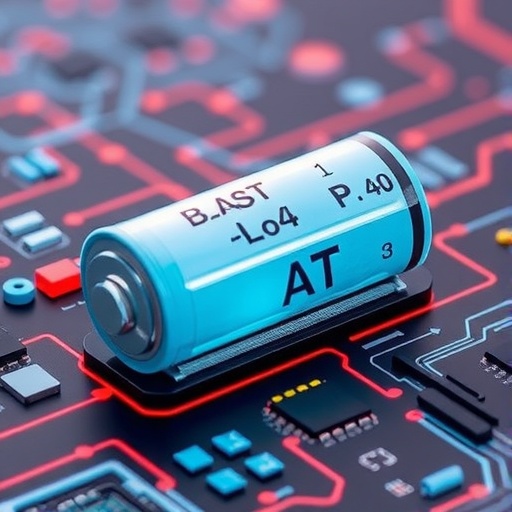In recent years, the advancements in battery technology have been pivotal in shaping the future of energy storage and electric vehicles. Among the various types of batteries, lithium-ion batteries have emerged as the preferred choice due to their high energy density and efficiency. However, one critical aspect that remains a challenge is the accurate estimation of the state of health (SoH) of these batteries throughout their life cycle. Recent research conducted by Zheng, Wei, and Deng has introduced an innovative methodology that utilizes a Savitzky Golay filter combined with a sophisticated neural network architecture, namely NGO-CNN-BIGRU, to enhance the precision of SoH estimation in lithium-ion batteries.
One of the main obstacles in battery management systems is the reliable assessment of the battery’s state of health. This metric is crucial for determining the optimal performance, safety, and lifespan of a battery. Traditional methods often rely on electrochemical metrics, which can be complex and require extensive computational resources. The new approach proposed by Zheng and colleagues aims to simplify this process while improving accuracy. By employing the Savitzky Golay filter, their model effectively smoothens data, preserving important trends that aid in the prediction of health metrics.
The combination of the Savitzky Golay filter with the NGO-CNN-BIGRU model represents a significant leap forward in the field. The CNN, or Convolutional Neural Network, is adept at processing grid-like data structures such as images or time series. It excels in capturing spatial hierarchies and has proven its effectiveness in various applications, from image recognition to natural language processing. When paired with the Bidirectional Gated Recurrent Unit (BIGRU), which enhances performance by processing sequences in both forward and backward directions, the model gains a comprehensive understanding of the temporal dynamics of battery health.
Zheng’s team carried out rigorous experiments to validate their proposed SoH estimation method. They utilized a dataset comprising real-world battery usage patterns, which allowed for a more robust and realistic assessment. The results demonstrated that the proposed methodology outperformed several existing models in terms of accuracy and reliability. The use of the Savitzky Golay filter mitigated noise and artifacts in the data, enabling the CNN and BIGRU to focus effectively on the underlying patterns indicative of the battery’s health status.
Furthermore, the implementation of machine learning techniques in battery health assessment paves the way for more intelligent and adaptive energy systems. As the electric vehicle market continues to expand, the demand for robust battery management solutions becomes increasingly critical. The innovative model presented by Zheng and team not only provides immediate benefits by improving SoH estimations but also lays the groundwork for future advancements in battery technology.
One of the notable features of this research is its potential for scalability. The methodology’s adaptability suggests that it can be integrated into various battery types beyond lithium-ion technology. This versatility could play a vital role in developing a more sustainable battery infrastructure, supporting renewable energy systems and electric mobility solutions. As different battery chemistries gain traction in the market, establishing a reliable SoH estimation framework will be essential for ensuring safety and performance across all platforms.
Moreover, the intersection of artificial intelligence and battery management holds promise for creating predictive maintenance strategies. By leveraging machine learning models, researchers can forecast potential failures before they occur, thereby extending the life of batteries and minimizing operational disruptions. This proactive approach can save manufacturers and users significant costs associated with unexpected downtime and replacement.
The implications of such technology extend far beyond traditional battery applications. In sectors such as renewable energy storage, where lifecycle management of batteries is vital to optimizing performance and minimizing waste, such advanced methods can greatly contribute to a more sustainable energy ecosystem. The comprehensive understanding of battery health facilitated by Zheng’s model could ultimately lead to innovations in energy management systems that utilize batteries for a variety of applications.
As researchers continue to explore the intricacies of battery technology, it is clear that accurate SoH estimations will be fundamental in shaping the future of energy storage. Zheng and colleagues’ research represents a significant step forward in this endeavor, exemplifying how sophisticated data analysis techniques can enhance our understanding of battery performance. This study not only contributes to the academic body of knowledge but also has practical implications that can lead to more efficient battery systems in real-world scenarios.
Looking ahead, the potential for integration with smart technologies and Internet of Things (IoT) devices presents further opportunities for innovation. By connecting battery management systems with smart grids and monitoring solutions, users can achieve unprecedented levels of insight and control over energy resources. As we move towards a more interconnected energy landscape, the capacity for real-time health assessments of batteries will be indispensable.
In conclusion, the research conducted by Zheng, Wei, and Deng provides a groundbreaking methodology that enhances the accuracy of state of health estimations in lithium-ion batteries. The integration of the Savitzky Golay filter with the NGO-CNN-BIGRU model represents a notable advancement in battery management, with significant implications for energy storage and electric vehicle technologies. The insights gleaned from this study not only advance the field of battery research but also indicate a path towards a more sustainable and efficient energy future.
The world of battery technology is evolving, and with it comes the necessity for sophisticated health management systems that can keep pace with increasing demands. As this research demonstrates, innovation in battery health estimation is not just about enhancing performance today; it’s about laying the groundwork for the future of energy storage solutions.
Subject of Research: Advanced state of health estimation for lithium-ion batteries.
Article Title: State of health estimation for lithium-ion batteries based on Savitzky Golay filter-NGO-CNN-BIGRU.
Article References:
Zheng, D., Wei, R., Deng, W. et al. State of health estimation for lithium-ion batteries based on Savitzky Golay filter-NGO-CNN-BIGRU.
Ionics (2025). https://doi.org/10.1007/s11581-025-06634-1
Image Credits: AI Generated
DOI: https://doi.org/10.1007/s11581-025-06634-1
Keywords: Lithium-ion batteries, state of health, Savitzky Golay filter, CNN, BIGRU, battery management systems, machine learning.




